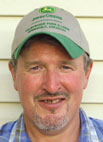
Environmental sustainability is the driving force behind the changes in diesel implement technology with the increasing number of agricultural machines being used in the field each year.
Clayton Rains, a sales representative at Legacy Farm and Lawn in Nevada, Mo., educates farmers and ranchers on the John Deere Final Tier 4 technology. Clayton’s goal is for people to understand the positive environmental impact these updates will provide and he encourages people not to be skeptical about the new technology.
Since 1996, the Environmental Protection Agency (EPA) instructed all manufacturers to design implements to meet low emission level requirements. Older model diesel implements emit high levels of nitrous oxide and particulate matter into the atmosphere.
The particulate matter is the “smoke” or soot that comes out of the exhaust pipe. According to the EPA, high levels of particulate matter can lead to adverse health affects, especially in the heart and lungs.
Nitrous oxide is harmful because it will combine with other substances in the atmosphere to create ground-level ozone, or smog, and contributes to acid rain.
“Back in 1996, there were no regulations on how much nitrous oxide could be produced from the motors. Each motor will produce a different amount of nitrous oxide. In 2015 the EPA required the particulate matter be at 20 percent nitrous oxide into the air,” Clayton explained. “John Deere and other manufactures have done extensive research to find out how they could meet these requirements.”
New features for the Final Tier 4 include the addition of an Exhaust Gas Recirculation (EGR), Diesel Oxidation Catalyst (DOC), Diesel Particulate Filter (DPF) and a Selected Catalytic Reduction (SCR). These four new features work together resulting in less Diesel Exhaust Fluid (DEF) consumption while maintaining overall performance and producing clean emissions.
The harmful nitrous oxide is broken down into nitrogen and water vapor when it combines with the Diesel Exhaust Fluid in the Selected Catalytic Reduction.
“John Deere has a particulate matter filter, which is why they do not use as much Diesel Exhaust Fluid,” Clayton explained. The exhaust system technology decreases the particulate matter that is emitted into the environment.
“The exhaust gets blown into the filter and that is where the soot is collected. It is nothing the customer has to do, it is self-cleaning. All they have to do is keep their tractor set on auto-burn and it will burn the soot out under normal operating conditions,” he said.
Clayton advises people to always shut their tractor off when going into a barn, stacking hay, or going anywhere a fire could start.
“The performance is still there,” said Clayton. “They have worked with the EPA to come up with clean air emissions and still have the motor performance we would expect out of each model,” he commented.
“The hardest thing for people is to take a step in a new direction; which is new maintenance costs and how it is going to affect their bottom line,” said Clayton as he explained how some people are reluctant to embrace the implement updates. “If we went back in time and looked at all of the people that said they would never own a tractor with a cab, air conditioner, radio, or any other unnecessary thing; many of those people would say they need those items now.
“I do believe this is an overall goal that will help our atmosphere,” he said. Although the EPA regulations that are imposed on all implements are not a necessity to perform.”
Clayton understands the long-term benefits.
“It has to do with the overall picture of a clean environment and it is a give and take situation,” he said. “If you look at the EPA from a good stand point you see they are trying to keep a clean atmosphere and clean environment for our next generation.”
Aside from working at Legacy, Clayton designed a Mobile Livestock Clinic in 2005. He received a 20-year patent on his product in February 2009. His Mobile Livestock Clinic is an accessory for producers to provide an efficient way to catch and treat a sick or calving cow. Clayton updated his original design to include a hydraulic gate for catching and working ease.







